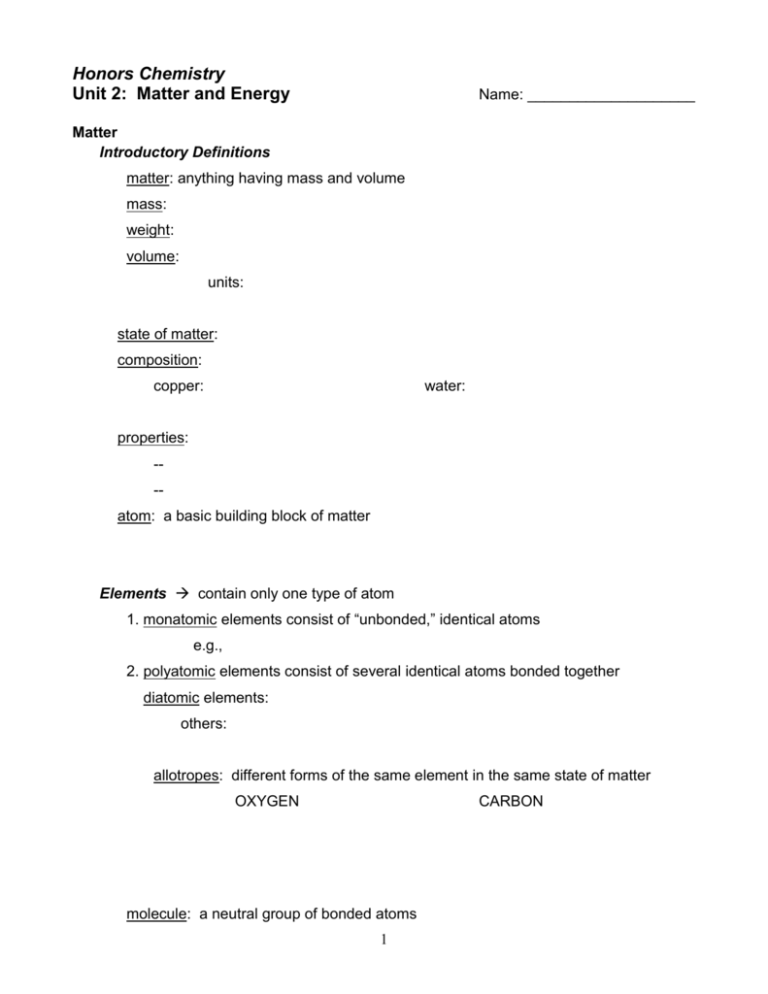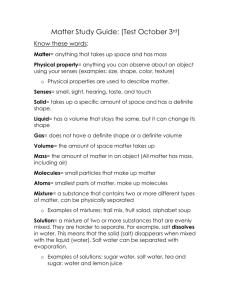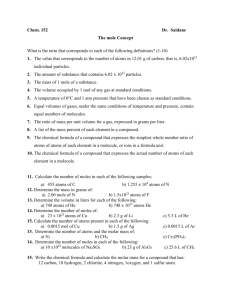Chemistry: Spring Semester Lecture Notes
advertisement

Honors Chemistry Unit 2: Matter and Energy Name: ____________________ Matter Introductory Definitions matter: anything having mass and volume mass: weight: volume: units: state of matter: composition: copper: water: properties: --atom: a basic building block of matter Elements contain only one type of atom 1. monatomic elements consist of “unbonded,” identical atoms e.g., 2. polyatomic elements consist of several identical atoms bonded together diatomic elements: others: allotropes: different forms of the same element in the same state of matter OXYGEN CARBON molecule: a neutral group of bonded atoms 1 Description Chemical Symbol Model 1 oxygen atom 1 oxygen molecule 2 unbonded oxygen atoms 1 phosphorus atom 1 phosphorus molecule 4 unbonded phosphorus atoms Compounds …contain two or more different types of atoms …have properties that are different from those of their constituent elements Na (sodium): Cl2 (chlorine): Atoms can be altered only by ____________ means. Molecules can be altered by ____________ means. e.g., Dehydration of sugar C12H22O11(s) 12 C(s) + 11 H2O(g) Electrolysis of water 2 H2O(l) 2 H2(g) + O2(g) 2 Compound Composition All samples of a given compound have the EXACT same composition, by mass. EX. Phosgene gas (COCl2) is 12.1% carbon, 16.2% oxygen, and 71.7% chlorine by mass. Find # of g of each element in 254 g of COCl2. EX. A certain sample of butane contains 288 g carbon and 60.0 g hydrogen only. Find… A. …total mass of sample B. …% of each element in butane C. …how many g of C and H are in a 24.2 g sample EX. A 550. g sample of chromium(III) oxide (Cr2O3) has 376 g Cr. How many grams of Cr and O are in a 212 g sample of Cr2O3? Classifying Matter (Pure) Substances have… and therefore also have… ELEMENTS COMPOUNDS e.g., e.g., 3 Mixtures two or more substances mixed together Mixtures have… and therefore also have… The components are NOT chemically bonded, so they… Two Types of Mixtures homogeneous: (or solution) heterogeneous: sample has same composition and different composition and properties properties throughout; evenly mixed in the same sample; unevenly mixed at the particle level e.g., e.g., alloy: a homogeneous mixture of metals suspension: settles over time e.g., EX. e.g., Contrast… 24K GOLD 14K GOLD Chart for Classifying Matter MATTER PURE SUBSTANCE ELEMENT COMPOUND MIXTURE HOMOGENEOUS 4 HETEROGENEOUS Separating Mixtures …involves physical means, or physical changes 1. sorting: 2. filter: 3. magnet: 4. chromatography: 5. density: decant: 6. distillation: **NO chemical reactions are needed to separate the components of a mixture because… Density how tightly packed the particles are Density = Typical units: g/cm3 for solids To find volume, use… g/mL for fluids 1. 2. ** Density of water = The density of a liquid or solid is nearly constant, no matter what the sample’s temperature. 5 Density Calculations EX. A sample of lead (Pb) has mass 22.70 g and volume 2.000 cm3. Find its density. EX. Another sample of lead occupies 16.2 cm3 of space. Find sample’s mass. EX. A 119 g solid cylinder has radius 1.80 cm and height 1.50 cm. Find sample’s density. 1.80 cm 1.50 cm 8.20 cm EX. A 153 g rectangular solid has edge lengths 8.20 cm, 5.10 cm 5.10 cm, and 4.70 cm. Will this object sink in water? 4.70 cm Properties of Matter CHEMICAL properties tell how a substance reacts with other substances. PHYSICAL properties can be observed without chemically changing the substance. EXTENSIVE properties depend on the amount of substance present. INTENSIVE properties do not depend on the amount of substance. Examples: electrical conductivity……………………...….. reactivity with water...…………………………. total internal energy………………….………… ductile: can be drawn (pulled) into wire….….. malleable: can be hammered into shape..….. brittle………….…………………..….…………. magnetism……………………………………… 6 States of Matter SOLID LIQUID (( )) (( )) (( )) (( )) (( )) (( )) (( )) (( )) (( )) (( )) (( )) (( )) (( )) (( )) (( )) GAS Changes in State _________ _______ SOLID ______ LIQUID ________ GAS ____________ _________ Energy: the ability to do work potential energy: -e.g., kinetic energy: --Law of Conservation of Energy: 2 H2 + O2 + 2 H2O For the combustion of acetylene… ENERGY 7 C2H2 + O2 CO2 + H2O Energy Changes endothermic change: system _________ heat exothermic change: system _________ heat -- if occurring in a beaker, -- if occurring in a beaker, the beaker feels… Choose “endo” or “exo.” the beaker feels… boiling subliming paper burning freezing condensing melting P Energy R Energy R P The Mole Atoms are so small, it is generally impractical to count them by the dozens, thousands, even millions. To count atoms, we use the concept of the mole. 1 mole of atoms = That is, 1 mole of atoms = _____________ atoms Mass (g) 1 mol = molar mass (in g) For any element on the Periodic Table, one mole of that element (i.e., 6.02 x 1023 atoms Island Diagram MOLE (mol) of that element) has a mass in grams equal to the decimal number on the Table for that Particle (atoms) element. 1 mol = 6.02 x 1023 particles 8 EX. How many moles is 3.79 x 1025 atoms of zinc? EX. How many atoms is 0.68 moles of zinc? EX. How many grams is 5.69 moles of uranium? EX. How many grams is 2.65 x 1023 atoms of neon? EX. How many atoms is 421 g of promethium? 9 Calorimetry: the measurement of heat flow -- device used is called a... specific heat (capacity), cp: amt. of heat needed to raise temp. of 1 g of a substance 1oC (1 K) -- For energy changes involving… heat of fusion, cf heat of vaporization, cv We can find the heat a substance loses or gains using: where q = heat m = grams of substance cp = substance’s heat capacity T = temperature change cX = cf OR cv EX. What is the energy change when 679 g of water at 27.4 oC are converted into water vapor at 121.2oC? cf = 333 J/g cv = 2256 J/g cp,l = 4.18 J/g-oC cp,s = 2.077 J/g-oC cp,g = 2.042 J/g-oC 10 Much calorimetry is carried out using a coffee-cup calorimeter. -- If we assume that no heat is lost to the surroundings, then the energy absorbed inside the calorimeter must equal the energy released inside the calorimeter. i.e., EX. A 56.5 g sample of water initially at 17.6oC is mixed with a 79.7 g sample of water initially at 94.5oC. Find the equilibrium temperature of the mixture. EX. A 75.0 g piece of lead (specific heat = 0.130 J/g-oC) initially at 435oC is set into 125.0 g of water initially at 23.0oC. What is the final temperature of the mixture? EX. A 23.6 g ice cube at –31.0oC is dropped into 98.2 g of water at 84.7oC. Find the equilibrium temperature. 11








